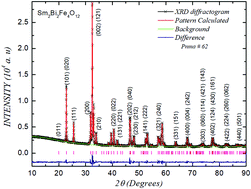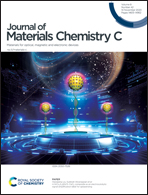Experimental and theoretical determination of physical properties of Sm2Bi2Fe4O12 ferromagnetic semiconductors†‡
Abstract
Polycrystalline samples of Sm2Bi2Fe4O12 were produced by the standard solid state reaction method. The structural characterization revealed that the material crystallizes in an orthorhombic structure (Pnma # 62 space group). Scanning electron microscopic images showed granular and densified characteristics on the surface and inside the samples, with two well-differentiated grain sizes: micrometric and submicrometric. From energy-dispersive X-ray spectra, it was established that the samples contained the expected elements in stoichiometric proportions suggested by the chemical formula of the compound. I–V curves and measurements of electrical permittivity as a function of temperature showed semiconductor-type behaviors, strongly dependent on the polycrystalline character of the material and a Maxwell–Wagner-type dielectric tendency. The optical spectral analysis corroborated the semiconductor behavior with the optical bandgap Eg = 2.62 eV. Temperature-dependent magnetization results have the expected form for ferromagnetic-type materials, with evidence of disorder that gives rise to magnetic irreversibility between the zero-field cooling and field cooling measurement procedures. Magnetization curves as a function of the applied field showed a hysterical response, even at room temperature, revealing the occurrence of ferromagnetic ordering in the material. The ab initio calculations of the electron density of states reveal the appearance of a mean semiconductor band gap whose value is in agreement with that measured experimentally. The effective magnetic moment is attributed to the majority contributions of the 3d-Fe orbitals. At low temperatures, the behaviors of the specific heat at constant volume and pressure are similar, with a tendency of the former towards the Dulong–Petit limit. Strong changes in all the thermophysical properties studied are evident due to the effects of pressure and temperature on the wave behavior of the crystal lattice. At higher temperatures, a strong variation in the Debye temperature induces divergence in thermophysical parameters for different applied pressures. The physical parameters related to the coexistence of the semiconductor and ferromagnetic properties in the material suggest possible technological implications in the spintronics industry.

- This article is part of the themed collection: Celebrating Latin American Talent in Chemistry


 Please wait while we load your content...
Please wait while we load your content...